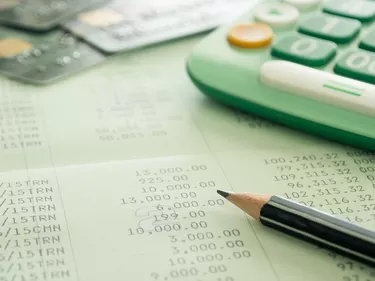When you look at a monthly credit card statement, you see an amount labeled "account balance" or "new balance." This is the outstanding balance. As of early 2018, the average outstanding credit card balance for Americans was $6,375. Carrying a big credit card balance will cost you a pretty penny in interest — and it won't help your credit rating, either.

Video of the Day
The Amount You Owe
An outstanding balance on a credit card account is simply the total amount you owe at a given time. For example, the outstanding balance on your monthly bill is the total debt as of the statement date. Outstanding balance is computed starting with the old balance from the previous month.
Video of the Day
The card issuer credits payments and adds new purchases, fees and interest to calculate the current outstanding balance. The typical statement often includes your previous balance, most recent payment and purchases, any interest applied and your current outstanding balance.
Even if you pay your credit card bill on time every month, a large outstanding balance can damage your credit score.
Interest Charges
Carrying a large outstanding balance on credit cards comes with a hefty price tag in interest charges. Suppose you run a monthly balance of $7,000, or a bit more than the national average. If you're paying 15 percent interest, that comes to $87.50 per month or $1,050 per year. Paying down credit cards and then paying the outstanding balance each month will eliminate most of this interest expense. In fact, some credit cards feature a grace period. If you pay off the outstanding balance within the grace period every month, you won't pay any interest at all.
Compound Interest Adds Up
Compound interest means that interest is calculated and added to the outstanding balance periodically. From that point on, the added interest earns still more interest. Credit card issuers usually compound interest daily. This means your outstanding balance grows every day and so does the amount of interest you pay. If the stated interest rate is 15 percent, compounding raises the annual percentage rate to 16.4 percent. Thus, compound interest makes carrying an outstanding balance more expensive.
Outstanding Balances and Credit Scores
Even if you pay your credit card bill on time every month, a large outstanding balance can damage your credit score. This is because of something called the credit utilization rate. Credit reporting agencies calculate the utilization rate by dividing your credit limit into the outstanding balance.
Suppose your credit limit is $7,500 and the outstanding balance equals $6,000. This works out to a credit utilization rate of 80 percent. According to Experian, a high credit utilization rate indicates increased risk for lenders if they loan you money and therefore lowers your credit score. Experian suggests keeping the outstanding balance under 30 percent of your credit limit. To save more, pay off the outstanding balance every month.
Outstanding Balance Due
The term "outstanding balance due" is closely related to the concept of outstanding balance. Both terms refer to the total amount owed, but in different contexts. Normally, the only amount due each month on a credit card is the minimum payment. The rest of your outstanding balance is not due for payment. Outstanding balance due means the entire amount owed is due. Typically, you see this term used when an account is closed due to non-payment.